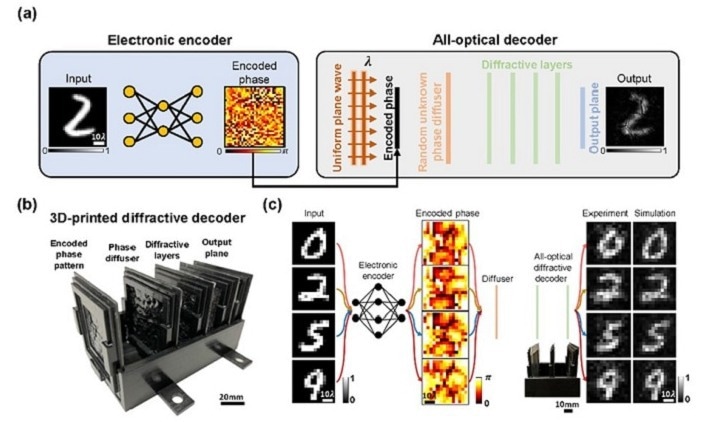Transporting optical data in free space using high transmission capacity and large bandwidth has received considerable attention in different applications, such as underwater communication, remote sensing, and medical devices.

Optical information transfer through random unknown diffusers using electronic encoding and diffractive decoding. (a) The workflow of the hybrid electronic-optical model: the electronic neural network encodes the input objects into 2D phase patterns and the all-optical diffractive neural network decodes the information transmitted through random, unknown phase diffusers. (b) Photograph of the 3D-printed diffractive decoder operating at THz part of the spectrum. (c) Experimental results of optical information transfer through an unknown random phase diffuser using the 3D-printed diffractive decoder with electronic encoding. Image Credit: Li et al., doi 10.1117/1.AP.5.4.046009
However, significant difficulties are posed by unforeseen, unknown phase perturbations or random diffusers within the optical path, which restrict the high-fidelity transmission of optical data in free space. Adaptive optics presents a potential solution that can rectify dynamically random distortions; spatial light modulators and iterative feedback algorithms employed unavoidably increase complexity and cost.
A group of scientists headed by Professor Aydogan Ozcan from the Electrical and Computer Engineering Department at the University of California, Los Angeles (UCLA), introduced a novel solution recently published in Advanced Photonics.
This new method employs electronic encoding and diffractive optical decoding to transfer optical data through random, unknown diffusers with high fidelity. Trained via supervised learning, this hybrid model uses a convolutional neural network (CNN)-based electronic encoder and co-optimized transmissive passive diffractive layers fabricated physically.
Following this one-time joint training process, the consequent hybrid model can precisely transfer optical data of interest even in unknown phase diffusers, efficiently generalizing to transfer data via unseen random diffusers. This new method considerably outperforms systems that only use a diffractive optical network or an electronic neural network for optical information transmission via diffusive random media, stressing the significance of having a diffractive decoder and an electronic encoder that function together.
This hybrid electronic-optical model's feasibility and experimental proof of concept were evaluated using a 3D-printed diffractive network functioning in the terahertz part of the electromagnetic spectrum. The hybrid model’s optical decoder could be physically scaled—either shrunk or expanded—to work across various parts of the electromagnetic spectrum, avoiding the requirement for retraining its diffractive characteristics.
The UCLA research group hopes this framework would offer a compact and low-power substitute for different applications, like the transmission of imaging data and biomedical sensing in implantable systems, data transmission through turbulent atmospheric conditions, and underwater optical communication.
Journal Reference
Li, Y., et al., Optical information transfer through random unknown diffusers using electronic encoding and diffractive decoding, Advanced Photonics, doi.org/10.1117/1.AP.5.4.046009.